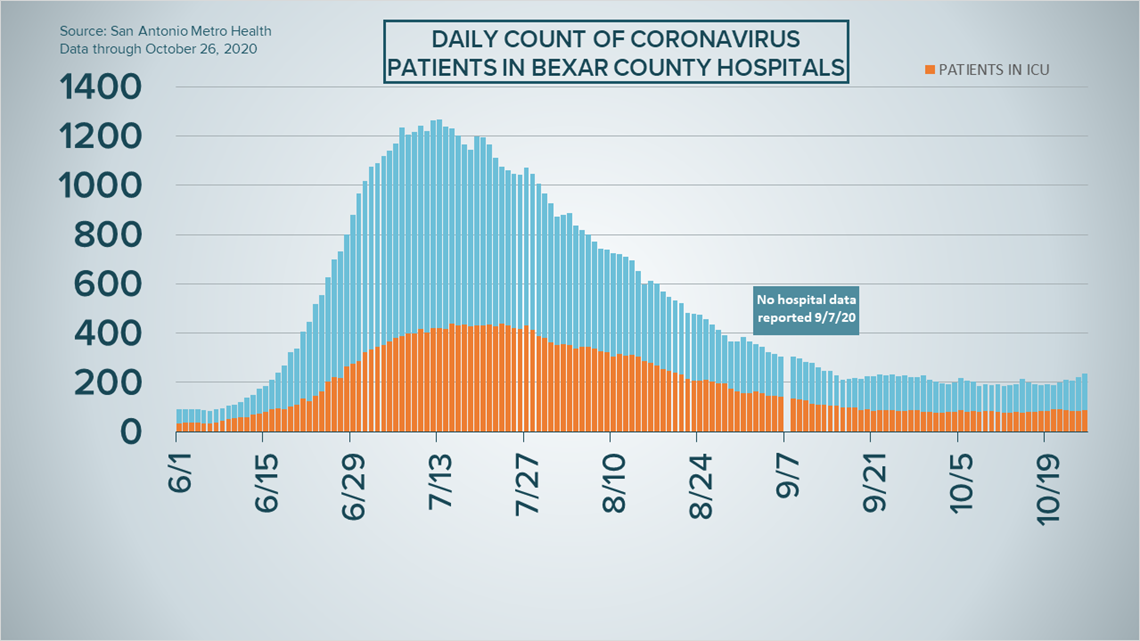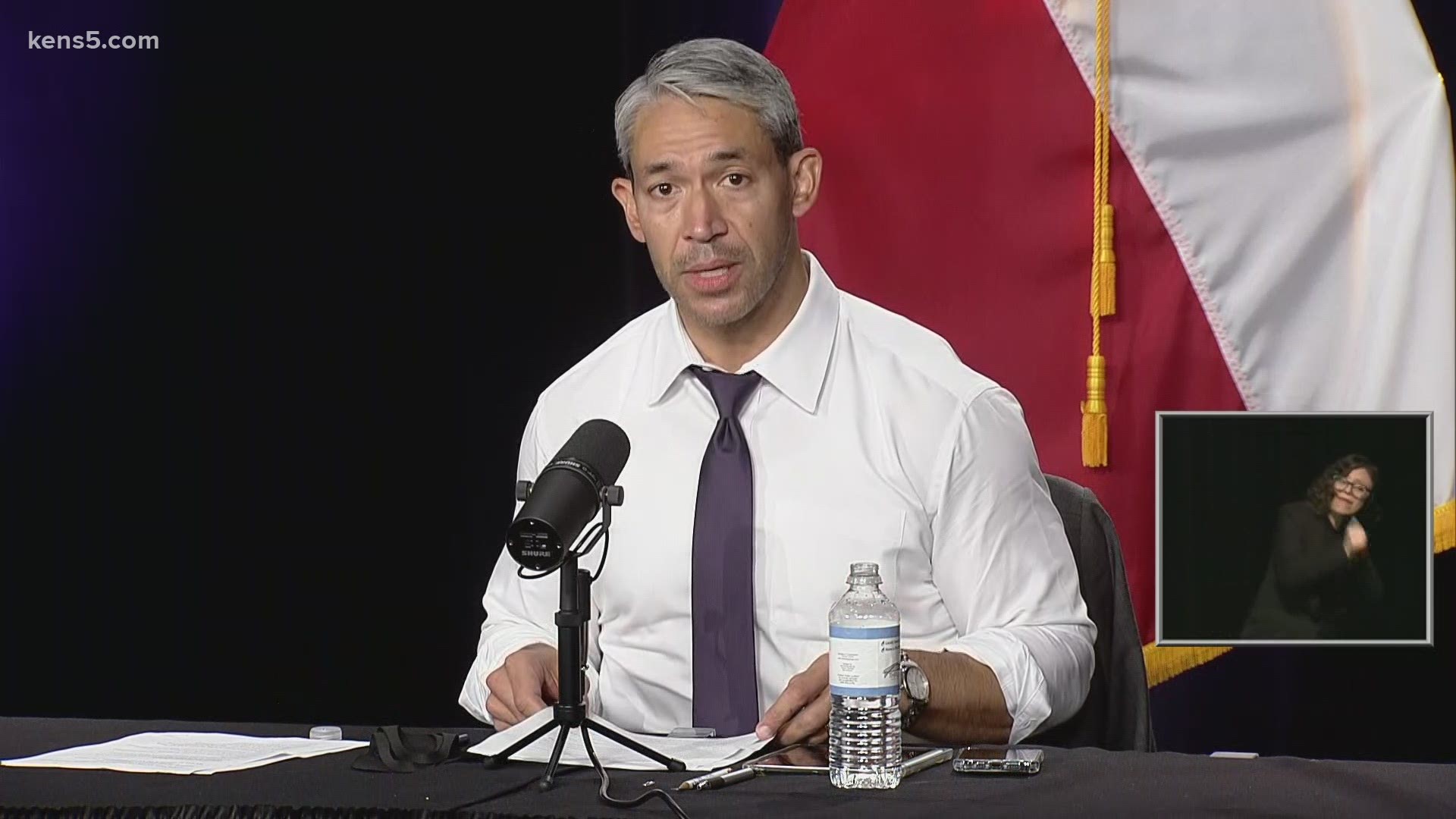SAN ANTONIO — We're tracking the latest numbers from the coronavirus pandemic in San Antonio and across Texas. Here are the latest numbers reported by Bexar and surrounding counties:
- Bexar County: 151 new cases were reported Monday, bringing the total number of cases for the county to 64,767. No new deaths were reported; the county's death toll remains at 1,247.
- Comal County: The county reported 27additional cases and no new virus-related deaths on Tuesday. There have been a total of 3,736 cases of COVID-19 in the county – including 2,861 lab-confirmed cases – while 120 county residents have died. County officials say there are 119 active coronavirus cases, and 3,497 residents are considered recovered.
- Hays County: Officials in Hays County on Monday reported 66 new cases in the county as well as no additional virus-related deaths. As of Monday, there are a total of 6,353 lab-confirmed cases in the county (505 of which are active) while the death toll remained at 86. 5,762 residents have recovered from the virus.
How Bexar County is trending
We've tracked how many coronavirus cases have been confirmed in Bexar County from the time officials began reporting cases in March 2020. The graphic below shows the number of cases since June and charts those daily case numbers along a 7-day moving average to provide a more accurate picture of the overall coronavirus case curve in our area and the direction we're trending amid the pandemic.
On Monday, San Antonio Mayor Ron Nirenberg reported 151 additional coronavirus cases in Bexar County. The county's seven-day moving average rose to 192.
Since the pandemic began, 64,767 county residents have been diagnosed with COVID-19.


No new deaths were reported; the county death toll remains at 1,247.
Hospitalizations rose again on Monday to 248, up 11 from Sunday. 91 of those patients are in intensive care, and 45 are on ventilators.


In his weekly COVID-19 Risk Level Indicator update for the county, Nirenberg cited a rebound in new cases and a jump in the positivity rate -- to 6.9% -- as points of concern. The overall risk level is now moderate.
The school indicator bar was raised to moderate as well due to the jump in the positivity rate.
Sunday, Pre-K 4 SA announced 4 staff members and a student tested positive for COVID-19. Monday, Nirenberg announced no additional staff members have tested positive for COVID-19; the city is currently testing children and family members and is awaiting results
Coronavirus in Texas
The number of Texans who have tested positive for the coronavirus since the pandemic began grew by 4,700 on Monday, according to the Texas Department of State Health Services.
4,418 of those are new diagnoses over the last 24 hours, while the other 282 cases stem from a number of backlogs in several counties. More details can be found at the top of this page.
In all, at least 867,075 Texans have contracted COVID-19.


State health authorities also reported 10 additional virus-related deaths on Monday. At least 17,514 Texans have passed away from COVID-19 complications.
Meanwhile, COVID-19-related hospitalizations in Texas ticked up to 5,278. That's a jump of 72 from the number reported Sunday. The number of patients in the hospital hovered above 3,000 at the end of September, but an October spike has brought hospitalization numbers not seen since August 22
Since last Monday, hospitalizations have risen by over 18%. Since Oct. 1, they've risen by nearly 40%.
Health officials warn that the state is currently in another surge. Experts attribute the spike in COVID-19 numbers to "pandemic fatigue." On Saturday, in the wake of a record-breaking surge in west Texas cases, Gov. Greg Abbott asked the federal government for permission to use a military medical center in Fort Bliss for non-coronavirus patients, thus freeing up space in El Paso for those receiving COVID-19 treatment.
The state estimates that 758,192 Texans have recovered, while 93,479 Texans remain ill with COVID-19.
Meanwhile, the Texas Education Agency updated its online coronavirus database to show that there have been 21,013 cumulative cases among staff and students across the state as of Oct. 22. More information can be found here.
The TEA releases new data on school cases every Thursday.
Latest Coronavirus Headlines
- Stocks have their worst day in a month as virus cases surge
- Pre-K 4 SA closes education center after staff members and a student test positive for coronavirus
- Coronavirus deaths are rising again in the US, as feared
- 'They are choosing to vote in person' | Bexar Co. election official gives update on early voting
- Coronavirus cases are creeping back up in Texas; mainly in people in their 20s and 30s, experts say
- El Paso imposes curfew as virus cases overwhelm hospitals
Coronavirus symptoms
The symptoms of coronavirus can be similar to the flu or a bad cold. Symptoms include fever or chills, cough, shortness of breath or difficulty breathing, fatigue, muscle or body aches, headache, new loss of taste or smell sore throat, congestion or runny nose, nausea or vomiting and diarrhea, according to the Centers for Disease Control.
Most healthy people will have mild symptoms. A study of more than 72,000 patients by the Centers for Disease Control in China showed 80 percent of the cases there were mild.
But infections can cause pneumonia, severe acute respiratory syndrome, kidney failure, and even death, according to the World Health Organization. Older people with underlying health conditions are most at risk.
But infections can cause pneumonia, severe acute respiratory syndrome, kidney failure, and even death, according to the World Health Organization. Older people with underlying health conditions are most at risk.
Experts determined there was consistent evidence these conditions increase a person's risk, regardless of age:
- Chronic kidney disease
- COPD (chronic obstructive pulmonary disease)
- Obesity (BMI of 30 or higher)
- Immunocompromised state (weakened immune system) from solid organ transplant
- Serious heart conditions, such as heart failure, coronary artery disease, or cardiomyopathies
- Sickle cell disease
- Type 2 diabetes
The CDC believes symptoms may appear anywhere from two to 14 days after being exposed.
Human coronaviruses are usually spread...
- Between people who are in close contact with one another (within about 6 feet).
- Through respiratory droplets produced when an infected person coughs, sneezes or talks. These droplets can land in the mouths or noses of people who are nearby or possibly be inhaled into the lungs.
- Some recent studies have suggested that COVID-19 may be spread by people who are not showing symptoms.
Help stop the spread of coronavirus
- Stay home when you are sick.
- Eat and sleep separately from your family members
- Use different utensils and dishes
- Cover your cough or sneeze with your arm, not your hand.
- If you use a tissue, throw it in the trash.

